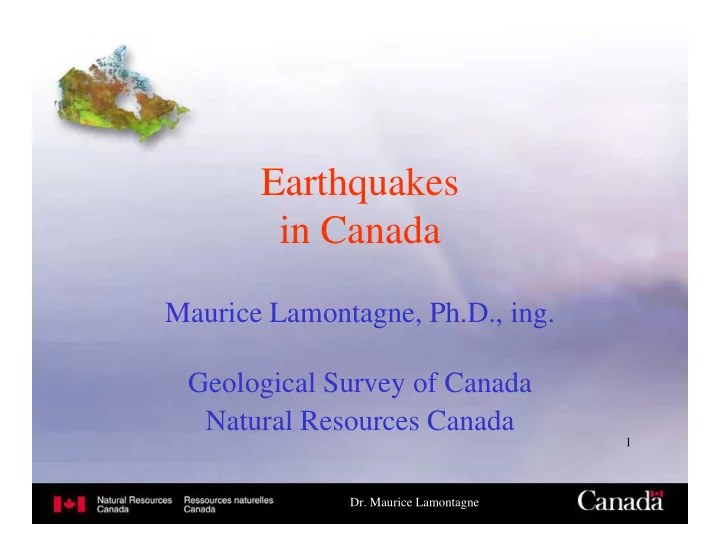

Earthquakes in Canada Maurice Lamontagne, Ph.D., ing. Geological Survey of Canada Natural Resources Canada 1 Dr. Maurice Lamontagne
2 2 Dr. Maurice Lamontagne What is an Earthquake? P P P S P S P S S S
Movement on a fault plane causes vibrations… The larger the area on which there is slip (rupture) – the larger the magnitude of the earthquake; – the longer the duration of rupture/ the more intense the vibrations/ the longer shaking lasts… 3 Dr. Maurice Lamontagne
Earthquake Magnitude (M) • Depends on the size of the reactivated fault surface; • Large subductionrelated earthquakes can exceed M8, almost all M8+ earthquakes occur at plate boundaries; • Earthquakes below M2.5 may not be felt and can be only detected by nearby seismographs. • For M4+, ground vibrations can be felt over large areas; • If near the epicentre, M5 is the minimum magnitude to make light objects fall, M5.5 can cause some damage to masonry; In eastern Canada: • Largest event was M7.0 (1663 Charlevoix earthquake, magnitude is estimated from historical records); 4 • Almost all earthquakes are weaker than M5, which is below the threshold that might cause damage to engineered facilities. Dr. Maurice Lamontagne
Global Seismicity over 20 years: concentrated at plate boundaries ≥ Mw 6.0 5 Mw ≥ 7.7 5 Dr. Maurice Lamontagne
Major earthquakes are related to movements at Plate Boundaries 6 6 Dr. Maurice Lamontagne
Three types of Plate Boundaries Diy.rgenl Conv .. gent TYIM 01 M.rgin Tr'IInatorm ulle.'.1 $Iiding SlIbductlon Motion Sp ... ,_ --, Destruct .... Comeivat ive Coo """'" ( oceanic lithosphere Cfea tlld) ( oceanic I/IhosptI&ra dastro,.ad) (lithosphere neilher created 0+' .. ''''''''. No map Iltect RIdgelRif\ Volcanic arc TCIP09"'phy , '0 \101(:,"1<: .alvity? No
Tectonic Context of Canada’s West Coast 8 Convergence 8 Dr. Maurice Lamontagne
NRCan Seismograph Network detects earthquakes in Canada High density of stations in eastern Canada 9 Dr. Maurice Lamontagne
Canadian National Earthquake Catalogue • Authoritative inventory of earthquake location, magnitude, depth, etc; • Based on written historical accounts and instrument records; • NRCan seismograph network can detect all earthquakes greater than M3.0 anywhere in Canadian territory; • Near some populated areas, the denser station network allows us to detect earthquakes as small as M1.0; • If the earthquake can be felt, we can record and measure it. 10 Dr. Maurice Lamontagne
Record of M6+ earthquakes in Canada and Significant earthquakes smaller events that were notable of Canada 1949 11 ywvutsrqponmlkjihgfedcbaTSRPNMIECBA 1700 1929 1663, 11 1925 Dr. Maurice Lamontagne
Earthquakes in eastern Canada • Earthquakes that can be felt in eastern Canada are rare; • They occur mainly in welldefined zones, characterized by many tens of small (<M3) earthquakes annually; • Most earthquakes that have caused any damage have occurred in known seismically active zones; • Most earthquakes occur at depths between 5 and 25 km, and represent reactivation of old faults deep in the Precambrian Basement; • Only one earthquake is known to have ever caused a surface fault rupture (Ungava); • Faults mapped at the surface are not necessarily seismically active; • The Canadian National Earthquake Catalogue and our knowledge are the basis for Seismic Hazard Maps. 12 Dr. Maurice Lamontagne
~ Earthquake Distribution of Eastern Canada H udsol1 Btl)' • o ~M' 8ank . 0 Zone 199 ,7.2) 0, 00 • o 1935 t'.2)' • Atlalltic O ce all C anadian Earthquakes knO'Hl to hive caused $OITl' damage o Magnitude 4.5 to 8.6 o o • MagnlbJde 3.0 to 4.5
Estimate of Seismic Hazard Map shaking that new Ro buste Historical seismicity + Geological Model buildings are required to withstand (under the National Building Code of Québec Canada) Montreal Ottawa Toronto Increasing Hazard 14 Sa(0.2) Dr. Maurice Lamontagne
~ ~ . 0 ~7 .Darlngton ~ . ~'Z ~ ~/-./ o Map of all M5 and greater earthquakes recorded in the region (Jan . 1900 -Mar 2011) * '........... " {J * . ....- Magnitude * 5.0 - 5.9 * * 6.0 6.9 15 km : , I' o 100' C, aIlada Dr. Maurice Lamontagne Natu ra l Resources Ressources n at urelles Canada Canada
Conclusions • Large earthquakes (M8+) are expected near plate boundaries such as subduction zones; • Eastern Canada is an "intraplate” environment, well away from plate boundaries; • Generally lowlevel of earthquakes in eastern Canada, but some welldefined zones are recognized as being more active (i.e. Charlevoix); • Historically, most eastern Canada earthquakes occur in these welldefined zones, but have produced only minor damage; • The region around Lake Ontario is one of low to moderate seismicity, earthquakes in the Canadian Shield are even more rare; • Historical observations and more recent continuous records of earthquake activity are used to develop seismic hazard maps that define the seismic provisions of the 16 National Building Code. Dr. Maurice Lamontagne
Recommend
More recommend